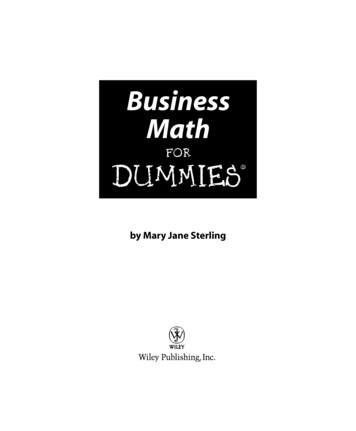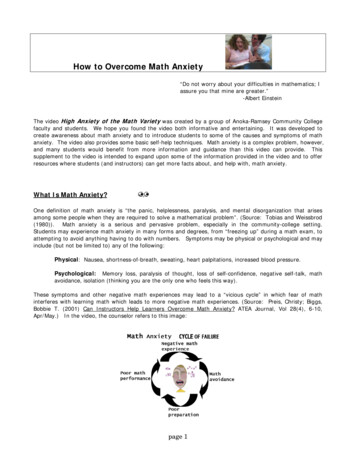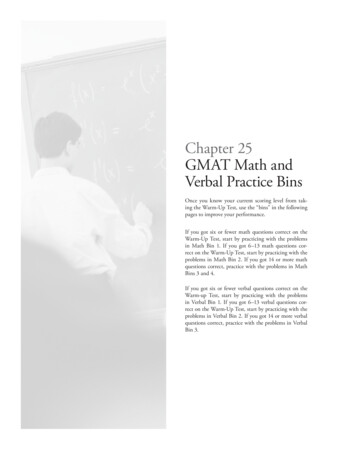
Transcription
01 233313-ffirs.qxd5/27/089:22 AMPage iiiBusinessMathFORDUMmIES‰by Mary Jane Sterling
01 233313-ffirs.qxd5/27/089:22 AMPage ii
01 233313-ffirs.qxd5/27/089:22 AMPage iBusinessMathFORDUMmIES‰
01 233313-ffirs.qxd5/27/089:22 AMPage ii
01 233313-ffirs.qxd5/27/089:22 AMPage iiiBusinessMathFORDUMmIES‰by Mary Jane Sterling
01 233313-ffirs.qxd5/27/089:22 AMPage ivBusiness Math For Dummies Published byWiley Publishing, Inc.111 River St.Hoboken, NJ 07030-5774www.wiley.comCopyright 2008 by Wiley Publishing, Inc., Indianapolis, IndianaPublished simultaneously in CanadaNo part of this publication may be reproduced, stored in a retrieval system, or transmitted in any formor by any means, electronic, mechanical, photocopying, recording, scanning, or otherwise, except aspermitted under Sections 107 or 108 of the 1976 United States Copyright Act, without either the priorwritten permission of the Publisher, or authorization through payment of the appropriate per-copy feeto the Copyright Clearance Center, 222 Rosewood Drive, Danvers, MA 01923, 978-750-8400, fax 978-6468600. Requests to the Publisher for permission should be addressed to the Legal Department, WileyPublishing, Inc., 10475 Crosspoint Blvd., Indianapolis, IN 46256, 317-572-3447, fax 317-572-4355, or onlineat http://www.wiley.com/go/permissions.Trademarks: Wiley, the Wiley Publishing logo, For Dummies, the Dummies Man logo, A Reference for theRest of Us!, The Dummies Way, Dummies Daily, The Fun and Easy Way, Dummies.com and related tradedress are trademarks or registered trademarks of John Wiley & Sons, Inc. and/or its affiliates in the UnitedStates and other countries, and may not be used without written permission. All other trademarks are theproperty of their respective owners. Wiley Publishing, Inc., is not associated with any product or vendormentioned in this book.LIMIT OF LIABILITY/DISCLAIMER OF WARRANTY: THE PUBLISHER AND THE AUTHOR MAKE NO REPRESENTATIONS OR WARRANTIES WITH RESPECT TO THE ACCURACY OR COMPLETENESS OF THE CONTENTS OF THIS WORK AND SPECIFICALLY DISCLAIM ALL WARRANTIES, INCLUDING WITHOUTLIMITATION WARRANTIES OF FITNESS FOR A PARTICULAR PURPOSE. NO WARRANTY MAY BE CREATED OR EXTENDED BY SALES OR PROMOTIONAL MATERIALS. THE ADVICE AND STRATEGIES CONTAINED HEREIN MAY NOT BE SUITABLE FOR EVERY SITUATION. THIS WORK IS SOLD WITH THEUNDERSTANDING THAT THE PUBLISHER IS NOT ENGAGED IN RENDERING LEGAL, ACCOUNTING, OROTHER PROFESSIONAL SERVICES. IF PROFESSIONAL ASSISTANCE IS REQUIRED, THE SERVICES OF ACOMPETENT PROFESSIONAL PERSON SHOULD BE SOUGHT. NEITHER THE PUBLISHER NOR THEAUTHOR SHALL BE LIABLE FOR DAMAGES ARISING HEREFROM. THE FACT THAT AN ORGANIZATIONOR WEBSITE IS REFERRED TO IN THIS WORK AS A CITATION AND/OR A POTENTIAL SOURCE OF FURTHER INFORMATION DOES NOT MEAN THAT THE AUTHOR OR THE PUBLISHER ENDORSES THE INFORMATION THE ORGANIZATION OR WEBSITE MAY PROVIDE OR RECOMMENDATIONS IT MAY MAKE.FURTHER, READERS SHOULD BE AWARE THAT INTERNET WEBSITES LISTED IN THIS WORK MAY HAVECHANGED OR DISAPPEARED BETWEEN WHEN THIS WORK WAS WRITTEN AND WHEN IT IS READ.For general information on our other products and services, please contact our Customer CareDepartment within the U.S. at 800-762-2974, outside the U.S. at 317-572-3993, or fax 317-572-4002.For technical support, please visit www.wiley.com/techsupport.Wiley also publishes its books in a variety of electronic formats. Some content that appears in print maynot be available in electronic books.Library of Congress Control Number: 2008927911ISBN: 978-0-470-23331-3Manufactured in the United States of America10 9 8 7 6 5 4 3 2 1
01 233313-ffirs.qxd5/27/089:22 AMPage vAbout the AuthorMary Jane Sterling is the author of four other For Dummies titles: Algebra ForDummies, Algebra II For Dummies, Trigonometry For Dummies, and Math WordProblems For Dummies. She has honed her math-explaining skills during heryears of teaching mathematics at all levels: junior high school, high school,and college. She has been teaching at Bradley University, in Peoria, Illinois,for almost 30 of those years.When not teaching or writing, Mary Jane keeps busy by working with herKiwanis Club, advising Bradley University’s Circle K Club, and working withmembers of the Heart of Illinois Aktion Club (for adults with disabilities).All the volunteer projects taken on for these clubs help keep her busy andinvolved in the community.DedicationI dedicate this book to my two business math inspirations. First, to my son,Jon, who came up with the idea of writing a book for business professionalswho needed a refresher — specifically for his real estate workforce. Andsecond, to my husband, Ted, who is the financial guru of the family and hashad years of experience in the business and financial arena.Author’s AcknowledgmentsI give a big thank you to Stephen Clark, who took on this project and neverceased to be encouraging and upbeat. Also to Jessica Smith, a wonderfulwordsmith and cheerful copy editor; her wonderful perspective and insightswill pay off big time for the readers. Thank you to Technical Editor BenjaminSchultz who helped out so much by keeping the examples in this book realistic and the mathematics correct. Thank you to Lindsay Lefevere who took theinitial suggestion and molded it into a workable project. And thank you toComposition Services, who took some pretty complicated equations and laidthem out in the most readable forms.
01 233313-ffirs.qxd5/27/089:22 AMPage viPublisher’s AcknowledgmentsWe’re proud of this book; please send us your comments through our Dummies online registrationform located at www.dummies.com/register/.Some of the people who helped bring this book to market include the following:Acquisitions, Editorial, andMedia DevelopmentProject Editor: Stephen R. ClarkAcquisitions Editor: Lindsay Sandman LefevereCopy Editor: Jessica SmithEditorial Program Coordinator:Erin Calligan MooneyTechnical Editor: Benjamin Schultz, MA,Lecturer, Department of BusinessCommunication, Kelley School of BusinessComposition ServicesProject Coordinator: Katie KeyLayout and Graphics: Carrie A. Cesavice,Stephanie D. Jumper, Julia TrippettiProofreaders: Melissa D. Buddendeck,Jessica KramerIndexer: Christine Spina KarpelesSpecial HelpDavid Nacin, PhDEditorial Manager: Christine Meloy BeckEditorial Assistants: Joe Niesen, David LuttonCartoons: Rich Tennant(www.the5thwave.com)Publishing and Editorial for Consumer DummiesDiane Graves Steele, Vice President and Publisher, Consumer DummiesJoyce Pepple, Acquisitions Director, Consumer DummiesKristin A. Cocks, Product Development Director, Consumer DummiesMichael Spring, Vice President and Publisher, TravelKelly Regan, Editorial Director, TravelPublishing for Technology DummiesAndy Cummings, Vice President and Publisher, Dummies Technology/General UserComposition ServicesGerry Fahey, Vice President of Production ServicesDebbie Stailey, Director of Composition Services
02 233313-ftoc.qxd5/27/084:12 PMPage viiContents at a GlanceIntroduction .1Part I: Reviewing Basic Math for Businessand Real Estate Transactions .7Chapter 1: Starting from the Beginning .9Chapter 2: Fractions, Decimals, and Percents .15Chapter 3: Determining Percent Increase and Decrease .31Chapter 4: Dealing with Proportions and Basic Algebra .37Part II: Taking Intriguing Math to Work .47Chapter 5: Working with Formulas .49Chapter 6: Reading Graphs and Charts .67Chapter 7: Measuring the World around You .79Chapter 8: Analyzing Data and Statistics .97Part III: Discovering the Math of Financeand Investments .109Chapter 9: Computing Simple and Compound Interest .111Chapter 10: Investing in the Future .131Chapter 11: Understanding and Managing Investments .149Chapter 12: Using Loans and Credit to Make Purchases .165Part IV: Putting Math to Use in Bankingand Payroll .177Chapter 13: Managing Simple Bank Accounts .179Chapter 14: Protecting Against Risk with Insurance .193Chapter 15: Planning for Success with Budgets .207Chapter 16: Dealing with Payroll .223Part V: Successfully Handling the MathUsed in the World of Goods and Services .235Chapter 17: Pricing with Markups and Discounts .237Chapter 18: Calculating Profit, Revenue, and Cost .251Chapter 19: Accounting for Overhead and Depreciation .273Chapter 20: Keeping Track of Inventory .291
02 233313-ftoc.qxd5/27/084:12 PMPage viiiPart VI: Surviving the Math for Business Facilitiesand Operations .305Chapter 21: Measuring Properties .307Chapter 22: Taking Out Mortgages and Property-Related Loans .335Part VII: The Part of Tens .359Chapter 23: Ten Tips for Leasing and Managing Rental Property .361Chapter 24: Ten Things to Watch Out for When Reading Financial Reports .369Index .373
02 233313-ftoc.qxd5/27/084:12 PMPage ixTable of ContentsIntroduction.1About This Book .1Conventions Used in This Book .2What You’re Not to Read .2Foolish Assumptions .2How This Book Is Organized .3Part I: Reviewing Basic Math for Business and Real EstateTransactions .3Part II: Taking Intriguing Math to Work .4Part III: Discovering the Math of Finance and Investments .4Part IV: Putting Math to Use in Banking and Payroll .4Part V: Successfully Handling the Math Usedin the World of Goods and Services .4Part VI: Surviving the Math for BusinessFacilities and Operations .5Part VII: The Part of Tens .5Icons Used in This Book .5Where to Go from Here .6Part I: Reviewing Basic Math for Businessand Real Estate Transactions .7Chapter 1: Starting from the Beginning . . . . . . . . . . . . . . . . . . . . . . . . . .9Fracturing the Myths about Fractions, Decimals, and Percents .10Capitalizing on Patterns in Formulas .11Finding the Power in Exponents .12Doing Some Serious Counting .13Painting a Pretty Picture .14Chapter 2: Fractions, Decimals, and Percents . . . . . . . . . . . . . . . . . . .15Changing from Fractions to Decimals .15Considering the two types of decimals .16Rounding decimals up or down .17Converting Decimals to Fractions .20Ending up with terminating decimals .20Dealing with repeating decimals .22Understanding the Relationship between Percents and Decimals .24Transforming from percents to decimals .25Moving from decimals to percents .25Dealing with more than 100% .26
02 233313-ftoc.qxdx5/27/084:12 PMPage xBusiness Math For DummiesComing to Grips with Fractions .27Adding and subtracting fractions .27Multiplying and dividing fractions .29Chapter 3: Determining Percent Increase and Decrease . . . . . . . . . .31Working with Percent Increase .31Computing new totals with increases .32Determining the percent increase .32Solving for the original amount .33Looking into Percent Decrease .34Finding new totals with decreases .35Figuring out the percent decrease .35Restoring the original price from a decreased price .36Chapter 4: Dealing with Proportions and Basic Algebra . . . . . . . . . .37Setting Up Proportions .38Solving Proportions for Missing Values .39Setting up and solving .40Interpolating when necessary .40Handling Basic Linear Equations .42Comparing Values with Variation .44Getting right to it with direct variation .44Going the indirect route with indirect variation .45Part II: Taking Intriguing Math to Work .47Chapter 5: Working with Formulas . . . . . . . . . . . . . . . . . . . . . . . . . . . . .49Familiarizing Yourself with a Formula .50Identifying variables and replacing them correctly .50Adjusting for differing units .51Recognizing operations .53Simplifying and Solving a Formula .54Operating according to the order of operations .54Making sure what you have makes sense .57Computing with Technology .57Calculators: Holding the answer in the palm of your hand .58Repeating operations: Simplifying your workwith a computer spreadsheet .62Chapter 6: Reading Graphs and Charts . . . . . . . . . . . . . . . . . . . . . . . . . .67Organizing Scattered Information with a Scatter Plot .68Lining Up Data with Line Graphs .70Creating a line graph .70Indicating gaps in graph values .71
02 233313-ftoc.qxd5/27/084:12 PMPage xiTable of ContentsMeasuring Frequency with Histograms .73Taking a Piece of a Pie Chart .76Dividing the circle with degrees and percents .76Chapter 7: Measuring the World around You . . . . . . . . . . . . . . . . . . . .79Converting from Unit to Unit .80Using the conversion proportion .80Lining up the linear measures .81Spreading out with measures of area .82Adding a third dimension: Volume .86Making Sense of the Metric System .88Moving from one metric unit to another .89Converting from metric to English and vice versa .91Discovering How to Properly Measure Lumber .92Measuring Angles by Degrees .94Breaking down a degree .94Fitting angles into polygons .95Chapter 8: Analyzing Data and Statistics . . . . . . . . . . . . . . . . . . . . . . . .97Organizing Raw Data .97Creating a frequency distribution .98Grouping values together in a frequency distribution .99Finding the Average .102Adding and dividing to find the mean .103Locating the middle with the median .104Understanding how frequency affects the mode .105Factoring in Standard Deviation .106Computing the standard deviation .106Part III: Discovering the Math of Financeand Investments .109Chapter 9: Computing Simple and Compound Interest . . . . . . . . . . .111Understanding the Basics of Interest .112Simply Delightful: Working with Simple Interest .112Computing simple interest amounts the basic way .113Stepping it up a notch: Computing it all with one formula .115Taking time into account with simple interest .116Surveying some special rules for simple interest .119Looking into the future with present value .120Getting to Know Compound Interest .122Figuring the amount of compound interest you’ve earned .122Noting the difference between effective and nominal rates .124Finding present value when interest is compounding .126xi
02 233313-ftoc.qxdxii5/27/084:12 PMPage xiiBusiness Math For DummiesDetermining How Variable Changes Affect Money Accumulation .127Comparing rate increases to increased compounding .127Comparing rate increases to increases in time .128Chapter 10: Investing in the Future . . . . . . . . . . . . . . . . . . . . . . . . . . . .131Calculating Investments Made with Lump Sums .132Reading interest earnings from a table .132Doubling your money, doubling your fun .136Going the Annuity Route .139Preparing your financial future with a sinking fund .139Determining the payment amount .141Finding the present value of an annuity .141Computing the Payout from an Annuity .143Receiving money from day one .144Deferring the annuity payment .146Chapter 11: Understanding and Managing Investments . . . . . . . . . .149Interpreting the Daily Stock Market Quotations .150Getting to know the stock quotations .150Computing percent change .153Using the averages to compute prices .154Wrangling with the Ratios .157Examining the stock yield ratio .157Earning respect for the PE ratio .158Working with earnings per share .159Calculating profit ratios .159Making Use of Your Broker .161Buying stocks on margin .162Paying a commission .163Investing in the public: Buying bonds .164Chapter 12: Using Loans and Credit to Make Purchases . . . . . . . . .165Taking Note of Promissory and Discount Notes .166Facing up to notes that have full face value .166Discounting the value of a promissory note .167Borrowing with a Conventional Loan .168Computing the amount of loan payments .169Considering time and rate .170Determining the remaining balance .171Paying more than required each month .172Working with Installment Loans .174Calculating the annual percentage rate .174Making purchases using an installment plan .175
02 233313-ftoc.qxd5/27/084:12 PMPage xiiiTable of ContentsPart IV: Putting Math to Use in Bankingand Payroll .177Chapter 13: Managing Simple Bank Accounts . . . . . . . . . . . . . . . . . .179Doing Business with Banks .179Exploring the types of business bank accounts available .180Understanding the importance of account management .181Balancing Act: How You and the Bank Use Your Account Balance .184Computing your average daily balance .184Determining interest using your daily balance .186Reconciling Your Account .188Making reconciliation simple .189Finding the errors .190Chapter 14: Protecting Against Risk with Insurance . . . . . . . . . . . . .193Surveying the Types of Insurance Available .194Living It Up with Life Insurance .194Insuring with a group .195Protecting your business with endowment insurance .198Protecting Yourself from Loss by Insuring Your Property .200Considering coinsurance .200Examining multiyear contracts .202Taking advantage of multiple building insurance coverage .203Deferring premium payments .206Chapter 15: Planning for Success with Budgets . . . . . . . . . . . . . . . .207Choosing the Right Type of Budget .207Cashing In on Cash Budgets .208Looking at an example cash budget .209Comparing budgeted and actual cash receipts .210Varying with a Flexible Budget .212Budgeting Across the Months .214Using revenue budgets to deal with staggered income .215Budgeting for ample inventory .216Measuring Differences with Variance Analysis .218Computing variance and percent variance .218Finding a range for variance .220Chapter 16: Dealing with Payroll . . . . . . . . . . . . . . . . . . . . . . . . . . . . . .223Pay Up: Calculating Employee Earnings .224Dividing to determine a timely paycheck .224Part-timers: Computing the salary of seasonaland temporary workers .226Determining an hourly wage .226Taking care of commission payments .228xiii
02 233313-ftoc.qxdxiv5/27/084:12 PMPage xivBusiness Math For DummiesSubtracting Payroll Deductions .232Computing federal income tax .232Determining Social Security contributions .234Part V: Successfully Handling the MathUsed in the World of Goods and Services .235Chapter 17: Pricing with Markups and Discounts . . . . . . . . . . . . . . .237Examining Markups and Retail Prices .237Making sense of markups .238Understanding how markups are a percentage ofretail prices .238Working with the retail price .240Exploring Discount Pricing .242Discounting once .243Successive or multiple discounts .245Going for a volume discount .247Chapter 18: Calculating Profit, Revenue, and Cost . . . . . . . . . . . . . . .251Figuring Profit from Revenue and Cost .252Understanding how volume affects profit, revenue, and cost .252Seeing how price is sensitive to demand .253Sorting out variable and fixed costs .256What’s It Gonna Be? Projecting Cost .260Dividing up direct and indirect costs .261Weighing historical and differential cost .263Determining Break-Even Volume .269Solving for break-even volume with a formula .269Working out break-even volume from historical data .270Chapter 19: Accounting for Overhead and Depreciation . . . . . . . . .273Keeping an Eye on Overhead Costs .
Mary Jane Sterling is the author of four other For Dummies titles: Algebra For Dummies, Algebra II For Dummies, Trigonometry For Dummies, and Math Word Problems For Dummies. She has honed her math-explaining skills during her years of teaching mathematics at











